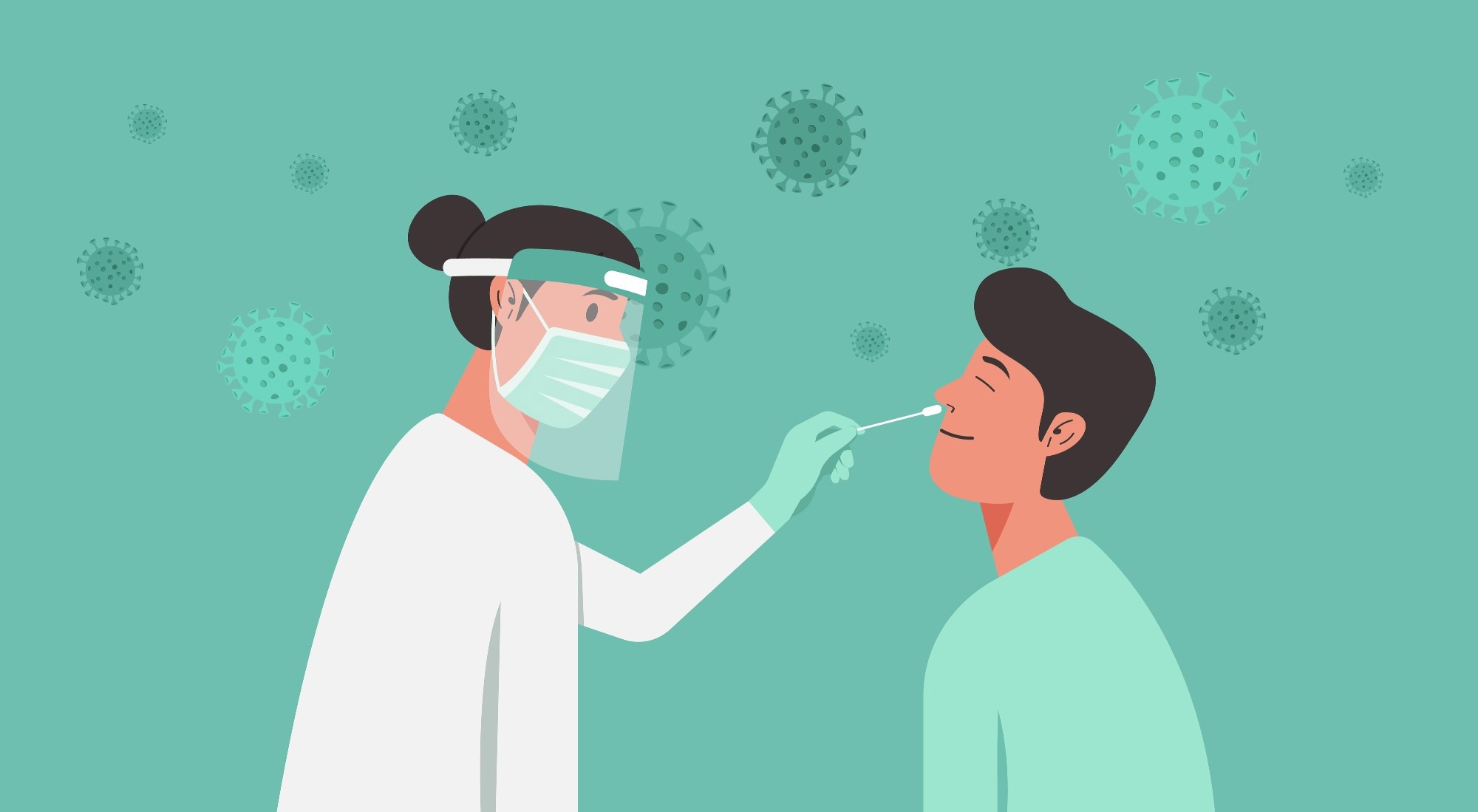SHEA advises against COVID screening of asymptomatic patients
In a recent recommendation published in the journal Infection Control and Hospital Epidemiology, the Society for Healthcare Epidemiology of America (SHEA) described the pros, cons, challenges, and factors to be considered for the use of asymptomatic coronavirus disease 2019 (COVID-19) screening to prevent severe acute respiratory syndrome coronavirus 2 (SARS-CoV-2) infections.
 Study: Asymptomatic screening for severe acute respiratory coronavirus virus 2 (SARS-CoV-2) as an infection prevention measure in healthcare facilities: Challenges and considerations. Image Credit: ST.art / Shutterstock
Study: Asymptomatic screening for severe acute respiratory coronavirus virus 2 (SARS-CoV-2) as an infection prevention measure in healthcare facilities: Challenges and considerations. Image Credit: ST.art / Shutterstock
The widespread utilization of laboratory diagnostic services for asymptomatic COVID-19 patients is referred to as ‘asymptomatic screening.’ The rationale for screening asymptomatic individuals is to identify potentially SARS-CoV-2-infected individuals unaware of the infection, preventing onward SARS-CoV-2 transmission. However, SHEA no longer recommends screening asymptomatic individuals for SARS-CoV-2 before admission to health facilities or prior to surgery.
In the recommendation, members of SHEA's board of directors reviewed data on asymptomatic screening as a measure for COVID-19 prevention and provided recommendations for usage of the same to reduce the COVID-19 burden.
“The small benefits that could come from asymptomatic testing at this stage in the pandemic are over ridden by potential harms from delays in procedures, delays in patient transfers, and strains on laboratory capacity and personnel,” said Thomas R. Talbot, MD, MPH, the Chief Hospital Epidemiologist at Vanderbilt University Medical Center, and a member of the SHEA Board of Directors. “Since some tests can detect residual virus for a long period, patients who test positive may not be contagious.”
Pros and cons of asymptomatic COVID-19 screening
Asymptomatic screening could enable early enforcement of isolation precautions and postponement of SARS-CoV-2-infected individuals for non-emergency AGPs (aerosol-generating procedures), which may otherwise increase SARS-CoV-2 transmission via aerosols of respiratory particles. Asymptomatic screening is mainly performed for individuals at hospital admission and before surgical procedures. However, it has been performed as a part of follow-up assessments for inpatients prior to initiating immunosuppressive medications, for periodic health assessments of non-vaccinated healthcare professionals (HCPs), and to enable HCPs exposed to SARS-CoV-2-positive individuals to resume work.
Antibodies eBook

However, asymptomatic screening may be associated with adverse outcomes such as (i) delayed patient placement and thus receipt of appropriate care, (ii) delays in transitions of patient care levels and strain on healthcare capacities from the increased LOS (length of stay), (iii) postponement of critical procedures, (iv) strains on laboratories, testing resources and personnel, and (v) increase in costs.
Further, since asymptomatic testing utilized NAAT (nucleic acid amplification tests), capable of detecting residual SARS-CoV-2 ribonucleic acid (RNA) for prolonged periods after resolution of infection, a SARS-CoV-2-positive report might not indicate active SARS-CoV-2 infection and infectivity. Moreover, a patient testing SARS-CoV-2-negative 3.0 days before operative procedures might be infected but tested very early or become SARS-CoV-2-positive between testing and the procedure. The individual may be considered uninfected, which might reduce compliance with non-pharmaceutical interventions such as face mask wearing by healthcare workers.
Recommendations and factors to be considered for asymptomatic screening
The team recommended that guides to assess SARS-CoV-2 transmission risks be used to assess the need for asymptomatic screening. Factors to be considered when assessing the requirement for asymptomatic screening include (i) COVID-19 incidence and SARS-CoV-2 transmission in community-based settings, (ii) identification of high-risk individuals, (iii) facility layout, and (iv) procedures that might elevate the SARS-CoV-2 transmission risks.
Metrics used by the CDC (Centers for Disease Control and Prevention) to assess the COVID-19 burden in communities include the (i) ‘COVID-19 community level’ metric, which uses biomarkers of inpatient surges in SARS-CoV-2 infections (SARS-CoV-2 infection-associated hospitalization rates and proportion of staffed inpatients’ beds by SARS-CoV-2-positive individuals), and (ii) ‘community transmission level’ which uses overall rates of COVID-19 cases and SARS-CoV-2-positive testing to evaluate transmission, especially in health facilities.
Other metrics can indicate heightened risks of healthcare settings-related SARS-CoV-2 transmission, such as COVID-19 incidence in healthcare facilities (e.g., COVID-19 cases detected one week after hospitalization), SARS-CoV-2 ribonucleic acid detection in wastewater supplies, and health professional absenteeism. Facilities providing stem cell transplantation or care for hematological cancer patients might require lower thresholds for asymptomatic COVID-19 screening.
Additionally, regions comprising individuals who might not be very likely to document novel COVID-19 symptoms or comply with infection prevention measures may be at increased risk of COVID-19 severity outcomes and, thus, require asymptomatic screening. SARS-CoV-2 vaccination data could also be used for identifying vulnerable individuals. Finally, healthcare facilities such as semi-private rooms or units utilizing congregate settings may increase SARS-CoV-2 transmission risks.
To conclude, based on the findings, the utilization of asymptomatic COVID-19 screening as a tool for preventing SARS-CoV-2 infections may be beneficial but is resource-intensive and has been overutilized. Before performing extensive asymptomatic screening, strengthening non-pharmaceutical protective measures such as using N95 respirators when performing particular AGPs, active vs. passive COVID-19 screening for HCPs, and improving facility layouts by increasing well-ventilated private rooms would be more feasible. Assessing SARS-CoV-2 transmission risks in communities and healthcare units and identifying high-risk populations before incorporating asymptomatic COVID-19 screening in institutional health practices is essential.
- Talbot, T., Hayden, M., Yokoe, D., Malani, A., Amer, H., Kalu, I., Wright, S. (2022). Asymptomatic screening for severe acute respiratory coronavirus virus 2 (SARS-CoV-2) as an infection prevention measure in healthcare facilities: Challenges and considerations. Infection Control & Hospital Epidemiology, 1-6. doi:10.1017/ice.2022.295, DOI: 10.1017/ice.2022.295, https://www.cambridge.org/core/journals/infection-control-and-hospital-epidemiology/article/asymptomatic-screening-for-severe-acute-respiratory-coronavirus-virus-2-sarscov2-as-an-infection-prevention-measure-in-healthcare-facilities-challenges-and-considerations/5D9FF2904AD88CDBDA5CAFD29A965A69
Posted in: Medical Research News | Medical Condition News | Disease/Infection News | Healthcare News
Tags: Cancer, Cell, Coronavirus, Coronavirus Disease COVID-19, covid-19, Diagnostic, Epidemiology, Healthcare, Hospital, Infection Control, Laboratory, Nucleic Acid, Pandemic, Respiratory, Ribonucleic Acid, RNA, SARS, SARS-CoV-2, Severe Acute Respiratory, Severe Acute Respiratory Syndrome, Surgery, Syndrome, Virus

Written by
Pooja Toshniwal Paharia
Dr. based clinical-radiological diagnosis and management of oral lesions and conditions and associated maxillofacial disorders.
Source: Read Full Article
